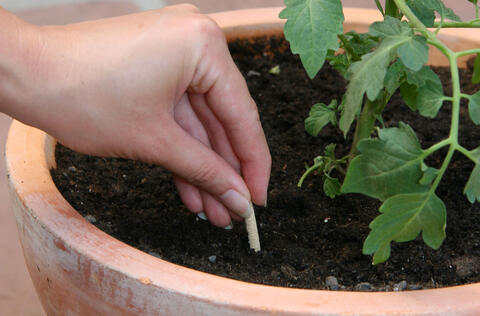5 Tips for Growing Tomatoes in Pots
You don’t need a vegetable garden to grow your own tomatoes. The healthy vegetable also thrives wonderfully in large pots on the balcony or patio – here are five tips for even more success.

The much-loved tomato not only delights traditional vegetable gardeners. The plants also do extremely well in pots on a sunny balcony or patio and are much less work than many people think. Here are our five tips for a successful balcony harvest!
When planting tomatoes in May/June, make sure the pots you choose are not too large. A container that holds seven to twelve liters of soil is sufficient. Put the pots in a warm spot, out of direct sunlight and sheltered from the rain. Make sure the plants have a regular supply of water and fertilizer. Do not pour the water over the leaves as this can cause blight.
No need to worry about the variety you choose: It’s not only smaller growing balcony varieties - such as ‘Miniboy’ at a height of just 20 inches - that do well in flower pots. Planted in pots with a high-quality vegetable soil mix, larger bush and stake tomatoes also produce delicious fruit – however, the latter needs to be well supported, ideally using ‘tomato cages’ made from wire mesh. Spiral rods are not suitable for tomatoes in pots, as they do not provide enough support in potting soil. Strong young plants are one of the most important requirements for successfully cultivating tomatoes. Specimens that are too weak or etiolated produce a smaller yield and are more susceptible to pests. It is therefore better to sow a few more and to only use the best young plants for further cultivation.

When you plant the tomatoes in May or June, make sure the pots are not too large: Containers that hold seven to twelve liters of soil are sufficient. Too much soil can cause root problems (root rot), it is difficult to control the moisture if the pots are too small, and they need to be watered more often on hot days. The planting hole should be deep enough to cover 1.96 to 3.93 inches of the base of the stem. This way, the plants form additional roots on the lower part of the stem, enabling them to absorb more water and nutrients. A word of caution: The pot ball should only just be visible for grafted tomatoes. Make sure that excess water can drain off well from openings at the base of the pot, as waterlogging can cause the roots to rot.

Tomatoes in pots love warm spots close to the house, but not full sun. The roots may overheat on unshaded south-facing balconies and this often causes the plants to wilt, even if the soil is moist. Some shade from a tree or umbrella can be helpful around midday. If you want to overwinter tomatoes in pots, you will need a bright location indoors or in a heated greenhouse.
Even though tomatoes are fairly easy plants to grow, they do still have one serious adversary: blight. This is caused by a fungal pathogen called Phytophthora infestans and can result in significant yield loss. The leaf disease is favored by moist environments. Fortunately, there are several ways to reduce the chances of infection: Put your potted tomatoes under a porch or in a special tomato house so that they are not exposed to rain and make sure that the leaves do not become wet during watering. Once your tomatoes have reached a certain size, you should remove the leaves that are close to the soil as a precaution.

Although tomatoes are strong growers, it is best to give them just one dose of tomato fertilizer each week according to the instructions on the packet. Slow-release fertilizers have proven unsuitable for tomatoes in pots, as the nutrient release is heat and water-dependent and is therefore irregular. It is also important that the plants have a steady supply of water, otherwise the fruit will split.
With around five hours of full sun on the balcony, the tomatoes will best develop flavors typical of the variety. A fertilizer rich in magnesium and potassium can also enhance the taste. Moderate watering increases dry matter content and reduces the water content. Scientists from the University of Pisa (Italy) have found that cherry tomatoes watered with 12% seawater remain smaller, but produce more flavor and healthy antioxidants. You can achieve the same results by also adding 0.04 ounces of sea salt per liter of water when fertilizing. You should, however, pay close attention to the reactions of your tomato plants, and if in doubt, stop adding salt, as if the soil becomes too salty, the plant will be unable to absorb important nutrients like calcium.





